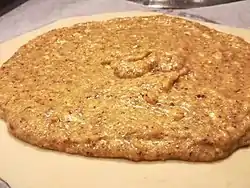Frangipane
Frangipane (/ˈfrændʒɪpæn, -peɪn/ FRAN-jih-pa(y)n, Italian: [ˌfrandʒiˈpaːne]) is a sweet almond-flavored custard used in a variety of ways including cakes and such pastries as the Bakewell tart, conversation tart, Jésuite and pithivier.[1] A French spelling from a 1674 cookbook is franchipane with the earliest modern spelling coming from a 1732 confectioners' dictionary.[2] Originally designated as a custard tart flavored by almonds or pistachios it came later to designate a filling that could be used in a variety of confections and baked goods.
 Frangipane cream before baking | |
| Type | Custard |
|---|---|
| Main ingredients | Almonds or almond flavouring, butter, sugar, eggs |

Today it is normally made of butter, sugar, eggs, and ground almonds.
In some anecdotes it was the kind of sweet that the noblewoman Jacopa da Settesoli brought to St. Francis of Assisi in 1226, when he was dying.[3] The “almond sweet” might also be a Roman version of mustacciuoli.[4][3]
On Epiphany, the French cut the king cake, a round cake made of frangipane layers into slices to be distributed by a child known as le petit roi (the little king) who is usually hiding under the dining table.[5] The cake is decorated with stars, a crown, flowers and a special bean hidden inside the cake.[6] Whoever gets the piece of the frangipane cake with the bean is crowned "king" or "queen" for the following year.
Etymology
The word comes ultimately from Italian, named after Marquis Muzio Frangipani or Cesare Frangipani.[2][7] The word first denoted the frangipani plant, from which was produced the perfume originally said to flavor frangipane.[8] Other sources say that the name as applied to the almond custard was an homage by 16th-century Parisian chefs in name only to Frangipani, who created a jasmine-based perfume with a smell like the flowers to perfume leather gloves.[2][9][10] A few popular sources claim that an Italian nobleman invented the dish himself while at the court of Louis XIII.[11]
References
- Ayto, John (2013). The Diner's Dictionary. Oxford University Press.
- Davidson, Alan (2014). "frangipane". The Oxford Companion to Food (3rd ed.). Oxford: Oxford University Press. doi:10.1093/acref/9780199677337.001.0001.
{{cite book}}: CS1 maint: date and year (link) - Jørgensen, Johannes (1913). Saint Francis of Assisi : a biography. University of Connecticut Libraries. New York: Longmans, Green, and Co. p. 257.
"Illam autem comestionem vocant Romani mortariolum quae fit de amygdalis et zucario et de aliis rebus." Spec. (ed. Sab.) p. 221. Sabatier identifies this favourite food of Francis with the well-known stone-hard Roman mostaccioli (see Jorgensen's "Pilgrimsbogen," p. 61). On the other side f. Edouard d'Alencon: Frere Jacqueline, p. 19, n. 2; in mortariolum (in Old French mortairol) he sees rather "cette creme d'amandes bien connue aujourd'hui sous le nom de frangipane," a name in which he finds an allusion to Jacopa's name (her married name was Frangipani).
- Pryds, Darleen (2015), Cattoi, Thomas; Moreman, Christopher M. (eds.), "Lady Jacopa and Francis: Mysticism and the Management of Francis of Assisi's Deathbed Story", Death, Dying, and Mysticism: The Ecstasy of the End, Interdisciplinary Approaches to the Study of Mysticism, New York: Palgrave Macmillan US, pp. 15–34, doi:10.1057/9781137472083_2.pdf, ISBN 978-1-137-47208-3, retrieved 2021-12-12. P. 20 mentions she may have brought “mostacciolo, an almond confection)”
- Frangipane at BBC Good Food Retrieved 24 May 2013
- Mary Berry's Christmas recipes: Mincemeat Frangipane Tart at Telegraph UK Food and Drink Retrieved 14 May 2013
- "A pastry dough alternative: Frangipane". Newsday. Tribune Content Agency. 2013-07-22.
the Marquis Muzio Frangipani. Frangipani wasn't a great cook. Rather, he popularized almond-scented gloves among the European aristocracy.
- "frangipane | Definition of frangipane in English by Oxford Dictionaries". Oxford Dictionaries | English. Retrieved 2019-03-21.
- Johansen, Katia (December 2004). "Fleeting fragrance: the history, preservation, and display of perfumed costume" (PDF). International Journal of Costume. 4 (2): 42.
- Bender, David A. (2006). "frangipane (frangipani)". Bender's dictionary of nutrition and food technology. Arnold E. Bender (8th ed.). Boca Raton, FL: CRC Press. ISBN 0-8493-7601-7. OCLC 71842325.
Originally a jasmine perfume which gave its name to an almond cream flavoured with the perfume.
- "New Look for Pudding: FRANGIPANI PUDDING". The Washington Post, Times Herald. 20 June 1963. p. D14 – via ProQuest.
Bibliography
- "Frangipane." Oxford Companion to Food (1999), 316.